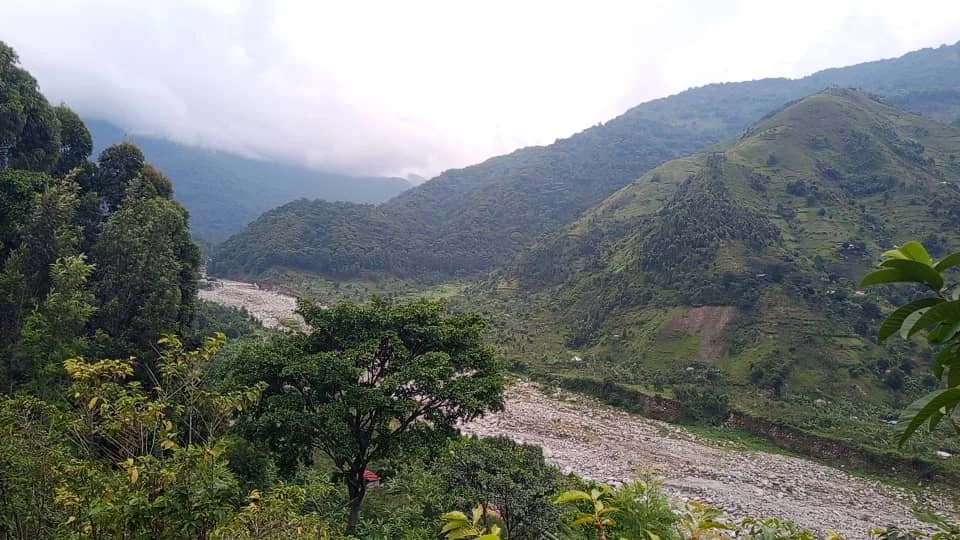From fire to flooding, the degradation of the Rwenzori Mountains
The Rwenzori Mountains are sometimes referred to as the mountain of the moon. On the border between the Democratic Republic of Congo and Uganda, these mountains host diverse landscapes from snow-capped peaks to lush montane forests and moorlands. But decades of deforestation means that vast areas of the land are prone to floods and landslides. Samuel, ITF’s Western Uganda Project Officer shares how ITF is working through local partners AWEI.
The land in this region is fragile characterised with floods, landslides and mudslides, that has caused an average of 5 people dying every year.
One of the major environmental disaster was in 2012, when a fire broke out in the Rwenzori National Park. I was 23 years old, I first heard about this fire on Facebook and on Messiah radio. But then, later I could see the glow of the fire on the mountain every evening, from 22km away.
Jackline, 14, lives in Kasika Village, where devastating landslides tore through the community
We could see the flames, the bush burning and a lot of smog in the sky even at a distance. Hundreds of scouts from the Rwenzururu kingdom joined the Uganda Wildlife Authority (UWA)and Uganda People’s Defence Force to manually fight the fire.
The fire burnt for about three months, burning over 4,700 hectares approximately 6% percent of the entire park. The fire destroyed a lot of vegetation, killed wild animals and birds and exposed the land.
There was never an official communication of what could have caused the fire outbreak, however UWildA suggested that the fire could have been set up by poachers during the dry season. The community felt so sad and frustrated, they expressed their anger towards the local leadership for having failed to put in place preventive measures.
From fire to flooding
The outbreak of the fire on Mountain Rwenzori national park left a large area of land bear. Floods, landslides and mudslides are now commonplace and taking lives each year.
Not long after the fire, the River Nyamwamba flooded. The very first time I heard and witnessed these floods was 1st May 2013 during the celebrations of international labour day.
Now the River Nyamwamba floods twice a year – in the two rainy seasons of March to May and August to October. It generally bursts its banks five times a season.
But it wasn’t just the fire. Human activities like construction, settlement, sand mining, river bed catchment have also affected the rivers natural flood barriers – reeds and bamboo. In Kasese district, more than 60 people have lost their lives due to the mudslide and floods in the last decade.
Planting a solution
ITF is working with Alpha Women’s Empowerment Initiative – a local community group who are restoring the landscape and creating sustainable livelihood opportunities for women.
AWEI is located on the slopes of the Rwenzori mountains, just nine kilometers away from Rwenzori National Park, they are playing a key role in trying to mitigate the causes of flooding and help those who have been victim to it.
They have been planting bamboo along the banks of the river and the streams that feed it, to help bind the soil and stop the river bursting its banks. Starting in 2023, over 471 community members and 11 institutions have been involved in planting over 23,000 bamboo.
And it is already having an impact. The bamboo planted so far is growing well and has started binding the soil along the river banks making it strong and will help in protecting the river floods from encroaching the banks of this river and the neighbouring landscape.
But they haven’t finished yet. AWEI plans to plant at least 200,000 bamboo along the River Nyamwamba and along other streams that feed into it. Alongside this they are training people in their community about importance and uses of bamboo and trees to the landscape, how to plant them and protect them and how to restore and respect the local landscape.
But there is still need to extent their services to other community members that have not yet benefited. We need to plant more bamboo and trees in more neighbouring villages and sub counties because the River Nyamwamba passes through many villages. There inadequate government funds to support environment conservation, we need your support today to help restore and protect this precious landscape. Thank you.
Donate today
Your donation today can help plant trees which prevent future catastrophes. Join Samuel, Jackline and the women of AWEI to restore landscapes and lives.



